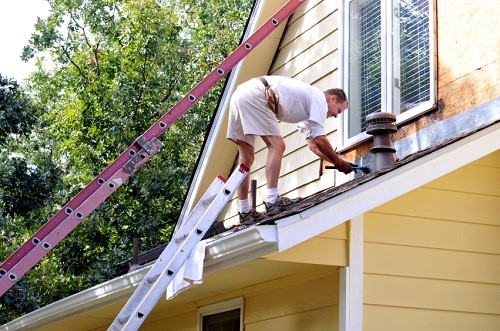Replacing the siding on your home is a big investment so it’s not surprising that many homeowners are intimidated by the thought of replacing their home’s siding. But not replacing that siding when the time comes can end up costing you even more in the long run in lost home value and damage to the underlying structure.
Why replace your siding? Aside from the aesthetic factors, the biggest threat caused by damaged siding is moisture damage. Once moisture starts seeping under your siding and into your sheet rock and wood framing, you’ve got the potential for some serious problems.
These are some of the most common indications that your home’s exterior needs new siding.
Cracked Siding
High winds, poor installation, high impact projectiles and other natural elements can cause your wood, aluminum or vinyl siding to crack or loosen over time. In addition to just generally looking bad, loose and cracked siding breaks the protective seal around your home that keeps out moisture and many pests.
Warped and Buckling Siding
If your vinyl siding looks wavy and bumpy, it’s probably due to improper installation or intense heat such as having your barbeque grill too close to the side of the house. Whatever the cause, there’s not much that can be done to fix this problem other than replacing it.
Seam Separation
If the seams in between the siding boards are pulling apart, then the siding may need to be replaced. This often occurs with improperly installed siding, foundation settling or siding that has aged over time. Whatever the case, moisture can enter at the open seams and cause damage to materials on the inside of the wall. In addition, eventually the siding panels will probably come loose and pull away from the house.
Interior Wall Damage
If the wallpaper or paint on interior walls is showing water stains or peeling off, you may actually be experiencing water infiltration through damaged siding. This can be common around windows if the siding-window barrier isn’t caulked properly. If not addressed, this can cause the wood under your siding to rot.
High Utility Bills
Uninsulated or poorly insulated siding may be costing you quite a lot of money in high utility bills. This phenomenon, known as thermal bridging, will cause heat to pass through your siding around the studs in the walls, driving up your energy bills. Replacing your siding will not only improve the structure of your home, but it can also get your utility bills back to a more reasonable rate.
Even though most siding replacement projects start out as a “pain” purchase, few home improvement projects will provide as much satisfaction and pride in ownership as a newly sided house. Make sure you’re prepared to ask the right questions when it’s time to replace your siding. Request a free quote today Download our FREE Siding Installation Checklist and start planning like a pro.








